“History will be kind to me for I intend to write it.”
—Sir Winston Churchill (1874-1965)
Mormonism is sometimes faced with instances where words uttered by one Church leader come into conflict with words uttered by a subsequent Church leader. When this happens, the Church has a variety of ways to deal with the issue. One is to say the previous Church leader was mistaken, misquoted or misunderstood. (See, The Adam-God Doctrine.)
Another way is to rewrite the words of the previous Church leader so as to remove the conflict.
The Elder Poelman Affair
I begin with a recap of one of the most bizarre instances of rewriting history in modern Mormonism.
Elder Ronald E. Poelman of the Seventy gave a talk in the Sunday morning session of 1984 General Conference titled, “The Gospel and the Church.” If you watch the opening moments of his address on the official LDS Church website, you will note that it begins with complete blackness behind Elder Poelman. 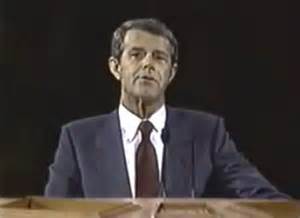 This is different than the opening moments of all other speakers during the Sunday morning session who begin with the lights up so the viewer can see the women of the Mormon Tabernacle Choir arrayed in white behind the speaker before the background fades to darkness. The other speakers whose talks begin with the choir members in view are Gordon B. Hinckley, James E. Faust, Royden G. Derrick , and Boyd K. Packer .
This is different than the opening moments of all other speakers during the Sunday morning session who begin with the lights up so the viewer can see the women of the Mormon Tabernacle Choir arrayed in white behind the speaker before the background fades to darkness. The other speakers whose talks begin with the choir members in view are Gordon B. Hinckley, James E. Faust, Royden G. Derrick , and Boyd K. Packer .
Why is it that Elder Poelman’s talk alone shows no choir members seated behind him at the beginning of his talk? The answer is that there was no choir there. Not only was there no choir, there was no audience sitting in the tabernacle, and no General Authorities sitting on the stand.
Elder Poelman was alone in the tabernacle when he gave this talk. Well, except for the video and audio people running the equipment; and the fellow coughing loudly so it would sound like there was an audience present.1
Not only is there a “cough track,” there is a quick cutaway at the very end of Elder Poelman’s talk to show him leaving the lectern. Lo and behold, the place is packed!  Everybody is present. How can this be? Because the last quick cut is from the original talk Elder Poelman actually gave in General Conference.
Everybody is present. How can this be? Because the last quick cut is from the original talk Elder Poelman actually gave in General Conference.
But if Elder Poelman did in fact give a talk during Conference, why was a later talk retaped and edited to make it look like the original?
This brings us to the heart of the matter.
The reason is because Elder Poelman’s original talk dealt with the subject of how the gospel is different from, and superior to, the Church, and sought to untether the individual practice of the gospel from Church leadership. This did not go over well with the powers that be who somehow managed to miss the objectionable material before it was delivered over live television by Elder Poelman.
Elder Poelman’s talk was accordingly rewritten to make it acceptable to whatever anonymous entity pulls these particular strings,  and Elder Poelman was sent back to the tabernacle with a camera crew to reshoot the revised talk which was edited in such a way as to make it appear to be the original address.
and Elder Poelman was sent back to the tabernacle with a camera crew to reshoot the revised talk which was edited in such a way as to make it appear to be the original address.
The only problem with this cunning plan was that VCR’s had already been invented, and at least one had apparently been in use by a Church member at home on the morning in question. From the taped original talk, a transcript was made, and those interested in seeing the amendments made for subsequent reshooting can do so here. (See how the choir can be seen behind Elder Poelman in the original talk?)
This story is familiar to many Latter-day Saints, though I confess to not being aware of it myself until only a few years ago.
But I told you that story to tell you this story, which may be less well known.
The Elder Faust Incident
There are other instances in which General Conference addresses have been edited for subsequent publication. A classic instance of this is Elder James E. Faust’s talk from the October 1976 session of General Conference. 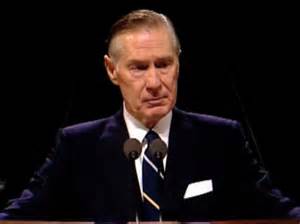 It is titled “A Personal Relationship with the Savior.” The talk can be viewed on the official Church website here, and was published in the November 1976 issue of The Ensign.
It is titled “A Personal Relationship with the Savior.” The talk can be viewed on the official Church website here, and was published in the November 1976 issue of The Ensign.
The very title of Elder Faust’s talk may strike some as unusual, given the fact that Elder Bruce R. McConkie gave a stern and somewhat infamous rebuke in 1982 to those who would advocate having a “personal relationship with Jesus Christ.”
And thereby hangs the tale.
For some reason, The Ensign decided to recycle Elder Faust’s 1976 talk in the January 1999 issue. The question obviously came up as to what to do with Elder Faust advocating a personal relationship with the Savior in light of Elder McConkie’s condemnation of the same.
First, let’s look at what Elder McConkie said in his 1982 address, “Our Relationship with the Lord”: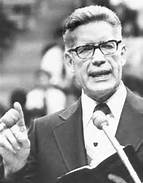
Now I know that some may be offended at the counsel that they should not strive for a special and personal relationship with Christ. It will seem to them as though I am speaking out against mother love, or Americanism, or the little red schoolhouse. But I am not. There is a fine line here over which true worshipers will not step.
* * *
And you have never heard one of the First Presidency or the Twelve, who hold the keys of the kingdom, and who are appointed to see that we are not “tossed to and fro, and carried about with every wind of doctrine” (Ephesians 4:14)–you have never heard one of them advocate this excessive zeal that calls for gaining a so-called special and personal relationship with Christ.
So why was Elder Faust not asked to retape his 1976 Conference address on “A Personal Relationship with the Savior”? Because there was nothing wrong with it when he gave it. It was not until 1982 when Elder McConkie laid down the law that Elder Faust’s 1976 talk became problematic.
The 1999 republication of Elder Faust’s 1976 Conference talk was made especially risky by the circumstance that, whereas the 1976 address was given upon his induction into the Quorum of the Seventy, by 1999 Elder Faust was not only one of the twelve (1978), but a member of the First Presidency (1995); the two groups about which Elder McConkie specifically stated, “[Y]ou have never heard one of them advocate this excessive zeal that calls for gaining a so-called special and personal relationship with Christ.”
What to do? What to do?
Well, of course the The Ensign publishers could have let the matter alone and not revisited the 1976 talk by Elder Faust (excuse me, President Faust). I mean, there are plenty of old Conference talks that could be used to fill out the January 1999 issue. But somebody apparently thought it important to justify Elder McConkie’s words that no apostle or member of the First Presidency would ever advocate a “personal relationship with Christ.” 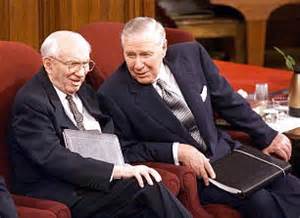 And in the case of Elder Faust, we had him on record in 1976 advocating precisely that, and from the mouth of a man who had gone on to become an apostle and member of the First Presidency.
And in the case of Elder Faust, we had him on record in 1976 advocating precisely that, and from the mouth of a man who had gone on to become an apostle and member of the First Presidency.
Something must be done to resolve the contradiction, it seems.
And so Elder Faust’s 1976 talk was reprinted; only it was quietly amended in such a way as to remove any reference to having a personal relationship with the Savior.
This, of course, had to begin with changing the title of Elder Faust’s talk. “A Personal Relationship with the Savior” had to go, as it was a sure indication President Faust had gone over the line beyond which Elder McConkie declared “true worshipers” would not step. In its place was substituted the less heretical title, “That We Might Know Thee.” There, that took care of the title. But more changes were needed.
As might be expected, Elder Faust’s 1976 Conference talk addressed the subject of its title throughout the text. Well, that could be changed, too. And it was. Without fanfare, and without comment. Below are the numerous changes made to the 1999 reprint of Elder Faust’s 1976 Conference talk to bring it into line with Elder McConkie’s 1982 speech.
1. Elder Faust (1976) told a personal story.
Recently in South America, a seasoned group of outstanding missionaries was asked, “What is the greatest need in the world?” One wisely responded: “Is not the greatest need in all of the world for every person to have a personal, ongoing, daily, continuing relationship with the Savior?”
But the 1999 version changed the wording:
Some time ago in South America, a seasoned group of outstanding missionaries was asked, “What is the greatest need in the world?” One wisely responded, “Is not the greatest need in all of the world for every person to have a personal, ongoing, daily, continuing relationship with Deity?” 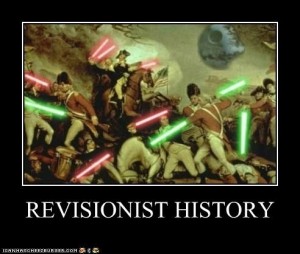
2. Elder Faust (1976) said this:
May I suggest five beginning, essential measures which will greatly clear the channel for a daily flow of “living water” from the very source of the spring, even the Redeemer Himself.
But the 1999 version changed the wording, omitting the final clause:
May I suggest five beginning, essential measures that will greatly clear the channel for a daily flow of “living water” from the very source of the spring (see John 4:7–15).
3. Elder Faust (1976) said this:
There is a great humility and timidity in my soul as I presume to speak about coming to a personal knowledge of Jesus Christ, the Redeemer of the world and the Son of God.
The 1999 version changed the wording:
There is great humility and timidity in my soul as I presume to discuss coming to a personal knowledge of God, the Eternal Father, and Jesus Christ, the Redeemer of the world and the Son of God.
4. Elder Faust (1976) said this:
A fervent, sincere prayer is a two-way communication which will do much to bring His Spirit flowing like healing water to help with the trials, hardships, aches, and pains we all face. What is the quality of our secret prayers when only He listens? As we pray, we should think of Him as being close by, full of knowledge, understanding, love, and compassion, the essence of power, and as having great expectations of each of us.
The 1999 version changed the wording, where in context the original suggested “His Spirit” was “Christ’s Spirit,” and “we should think of Him” meant “we should think of Jesus”:
A fervent, sincere prayer is a two-way communication that will do much to bring the Spirit flowing like healing water to help with the trials, hardships, aches, and pains we all face.  What is the quality of our secret prayers? As we pray, we should think of our Heavenly Father as being close by; full of knowledge, understanding, love, and compassion; the essence of power; and having great expectations of each of us.
What is the quality of our secret prayers? As we pray, we should think of our Heavenly Father as being close by; full of knowledge, understanding, love, and compassion; the essence of power; and having great expectations of each of us.
5. Elder Faust (1976) said this:
My witness is that we will be called upon to prove our spiritual stamina, for the days ahead will be filled with affliction and difficulty. But with the assuring comfort of a personal relationship with the Savior, we will be given a calming courage.
The 1999 version changed the wording:
My witness is that we will be called upon to prove our spiritual stamina, for the days ahead will be filled with affliction and difficulty. But with the assuring comfort of a personal relationship with God, we will be given a calming courage.
A comparison of the two talks shows they are virtually identical. But nowhere does The Ensign reference that the reproduced 1999 talk is a reprint of the 1976 Conference address. This may be because the editor of the 1999 article did not want to promote side-by-side comparisons such as the above on the part of the reader. Such a lack of transparency is less than reassuring.
A Question of Doctrine
Mormons tend to put great authoritative weight on doctrinal statements by General Authorities, especially when those statements are made in General Conference and published in The Ensign.
In light of this, how should we answer the question of whether it is proper to have a personal relationship with Jesus Christ? It was presumably doctrine in 1976 when spoken in General Conference by Elder Faust and published in The Ensign. But did it become against doctrine in 1982 when Elder McConkie gave his speech?
Elder McConkie was an apostle who outranked the Seventy status of Elder Faust, but do we factor in that Elder McConkie’s speech was not given in General Conference but at a BYU devotional? Does that lessen the authoritative nature of Elder McConkie’s pronouncement? And what do we do with the fact that as of the year Elder McConkie gave his speech (1982), Elder Faust had been an apostle for four years (1978)?
Perhaps of greater concern, was Elder Faust not a “true worshiper” (in Elder McConkie’s words) when he gave his talk in 1976? If not, how do we get around this conclusion while taking Elder McConkie’s words as authoritative? And would this not mean that the Church was inducting someone other than a “true worshiper” into the Quorum of the Seventy when Elder Faust was called in 1976?
And even worse, would it not also mean that Elder Faust was still an “untrue worshiper” two years later when he was called as an Apostle in 1978? Not to mention when he was called into the First Presidency in 1995?
Is this the Gordian Knot the 1999 Ensign article attempted to untie? And was it a sleeping dog better left alone?
Revising History
Most problematic of the changes to Elder Faust’s 1976 talk is likely the first example given above, in which Elder Faust speaks of a wise and seasoned missionary who asks, “Is not the greatest need in all of the world for every person to have a personal, ongoing, daily, continuing relationship with the Savior?”
Although the 1976 address was given when Elder Faust’s memory of the event would have been fresher, the words of this “outstanding” missionary were changed in 1999 to substitute “Deity” for “Savior.”
This is especially sticky because it is a historic event being recounted. Whether Elder Faust or an anonymous editor did the tinkering, it was not Elder Faust’s words being changed, but those of the missionary.
What the missionary said is a matter of history.  The missionary actually said something, and used specific words in saying it. The 1999 amendment of the missionary’s words suggests that even actual events are subject to subsequent modification in order to harmonize with doctrinal pronouncements by Church leaders.
The missionary actually said something, and used specific words in saying it. The 1999 amendment of the missionary’s words suggests that even actual events are subject to subsequent modification in order to harmonize with doctrinal pronouncements by Church leaders.
This is troubling because it raises the specter of what other historical accounts may have been revised so as to conform to later authoritative statements.
Now, I do not mean to sound Pollyannaish about the subject. This sort of thing happens all the time in other religions, and similar instances have been identified in both the Old and New Testaments.
It is just that it would be comforting to think that the foundational stories we are told about the Restoration are what actually transpired, and not have the doubt niggling in the back of our mind that the stories themselves may have been tampered with in order to make them square with doctrinal pronouncements by subsequent Church leaders.
The two case-studies of Elders Poelman and Faust do little to relieve the niggling.
NEWS FLASH!!!
This just in! In breaking news, the rewriting of Mormon history continues unabated. In an episode that future generations will no doubt refer to as “Photo-Swap-Gate,” the LDS Church has retroactively published the photos of women leaders in the November 2013 issue of The Ensign magazine.
Here are the bullet-points to the story:
March 6, 2014—The New York Times publishes an article linking to the Church’s General Authorities chart, showing photos of the all-male gallery of General Authorities published in each and every Conference Report issue of the The Ensign.
May of 2014–Likely in response to The New York Times article, The Ensign magazine  Conference Report is published which contains, for the first time in LDS history, the photos of the nine female General Officers of the Relief Society, Young Women and Primary in the Church’s General Authorities chart.
Conference Report is published which contains, for the first time in LDS history, the photos of the nine female General Officers of the Relief Society, Young Women and Primary in the Church’s General Authorities chart.
May 3, 2014–Ordain Women publicly announces this historic first on social media.
?????, 2014–At some point in time not readily ascertainable, the LDS Church goes back and adds the nine female General Officers to the General Authorities chart for the November 2013 issue of The Ensign.
Why go to such lengths to rewrite history? And over such a seemingly minor issue? Here is one possibility.
The LDS Church has a track record of not wanting to appear they are making changes in response to outside pressure. (See: The Lifting of the Priesthood Ban.)
Adding female authorities to the chart immediately after The New York Times article was published could make it look as if the Church did so in response to Ordain Women and their liberal friends in the secular media.
How to handle this problem? Through the miracle of the internet, the Church went back in time and added the nine female General Officers to the November 2013 chart.
Take that, New York Times! Take that, Ordain Women!
History will now show that the Church was ahead of the curve, and not caving into public pressure after all.
No unhallowed hand can stop the work of rewriting Mormon history.
__________________
1 Anderson, Lavina Fielding (1993), “The LDS Intellectual Community and Church Leadership: A Contemporary Chronology,” Dialogue: A Journal of Mormon Thought, 26 (1):23.


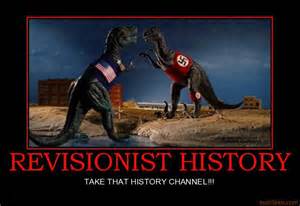



I knew about the Poelman talk, but not about the Faust talk–
Thank you for catching me up.
I was pretty sure the Poelman incident was more widely known, though probably only within a very small sampling of active LDS.
I think the Faustian episode is virtually unknown, though I think there must have been some awareness in the Church echelon of the conflict between Elder Faust (1976) and Elder McConkie (1982).
Else why go to all the trouble of revamping the Elder Faust talk in 1999?
There is usually some sort of impetus to engage in these hijinks.
Good post. It does make me wonder how aware Faust was of the Ensign article in 1999. I am sure he was aware of his conflict with McConkie.
It is pretty certain that Elder McConkie’s 1982 speech was directed at George Pace.
http://en.wikipedia.org/wiki/George_W._Pace
I think Elder Faust was just collateral damage.
But you are right. I am sure it made for some interesting discussions during the Thursday temple meetings with the twelve.
At what point can we trust that whether by the lords voice or the voice of the servant that it is actually true? As a temple recommend holding member I was required to answer the question if I was honest in all my dealings with my fellow man. Sadly enough the leaders of the church and the church institution cannot answer yes to that question.
It cannot be denied the LDS Church tends to look a tad hypocritical on that issue, Garrett.
Corbin, I would be interested in your analysis of the Church’s essays on controversial topics, including the one published to day on the Danites, the Mountain Meadows Massacre and other violent episodes in church history. Seems like there is a significant amount of re-writing going on there as well.
https://www.lds.org/topics/peace-and-violence-among-19th-century-latter-day-saints?lang=eng
I haven’t read the article yet, Porter, and am not an expert in late 19th century LDS History, either.
But am I safe in assuming there is no apology for the Mountain Meadows Massacre?
You’re right, Corbin. There is no apology. Although they do mention the excellent book “Massacre at Mountain Meadows” and do a decent job telling more about the incident than any previous manual, lesson, or letter.
I had a chance to review the new essay over lunch. On the whole, I think it did a good job at giving a (relatively) balanced approach to the subject.
At all the usual junctures where apologists tend to obfuscate, the essay does not. It mentions the Missouri antagonisms went both ways; includes material on the Danites; talks about Mormon depredations on Indians; includes the teaching of blood atonement in reference to the 1857 Reformation; does not flinch from describing the Mountain Meadows Massacre with the gruesome adjectives it deserves.
Although it goes out of its way to always use the modifier “some” when talking about bad acts by Mormons (i.e., “some” Mormons did this bad thing; and “some” Mormons did that bad thing), and makes it a focus to clear Joseph Smith and Brigham Young from complicity in any violent acts, I think on the whole it is better than I would have expected given the content of earlier essays.
Kudos Corbin Volluz!
Thanks, Brent!!!
My father-in-law Clare W says hi. Says you were the best bishopric counselor. Hope you are enjoying the magic skagit sunshine this week!
Clare is your father-in-law???
Wow! Small world!
That is very nice of Clare to say so.
The only time I have ever seen a “mantle” of leadership fall on somebody was when Clare was called as bishop.
He is a good guy!
Excellent post, Corbin. I was unaware of the Faustian whitewash. The thing about both the Poelman and Faust re-writes that I don’t quite understand is this: both ham-fisted attempts to send things down the memory hole seem to have been motivated by a desire on the part of the correlating powers within the church to address apparent contradictions between statements made by general authorities. But such contradictions are nothing new or uncommon; just the opposite–contradictions among living general authorities and even more so among living and past general authorities are legion. So why the focus on these two? The Poelman one makes some sense, as his talk really did strike at the heart of the power structure of the church. But the Faust one just doesn’t seem to pose the same threat. Was it just the result of a McConkie acolyte in the bowels of the COB trying to make sure that “Mormon Doctrine” was given the stamp of officialness that comes from publication in the Ensign?
Though I never expect to know the real reason for the publication of the edited version of Elder Faust’s talk in 1999, it would seem apparent that it was perceived to be a problem by somebody in authority.
Usually these types of things are not spotted as problems until and unless there has been a sufficient agitation in the rank and file to warrant action of some sort.
That is why, even though I am speculating in the absence of any evidence to my knowledge, I expect this was creating a substantial problem of some sort among the laity.
Or maybe Elder Faust was just getting tired of the good-natured ribbing he was constantly receiving in the COB elevator on the way to work in the morning.
The worst rewriting of all is the official story of the first vision which destroys the whole foundation of the LDS church for me.
For me too,Amelia.
You do realize that Elder Faust was ALIVE in 1999, and a member of the First Presidency. If any editing was done to his talk, you can be pretty sure that he did it himself.
So why don’t you let him speak for himself, rather than making him into some sort of a craven victim?
As for Elder Poelman, you ought to let him speak for himself, as well.
It appears that “speaking for himself” was the last thing Elder Poelman was allowed to do.
Because you bring up the fact that President Faust was alive in 1999, I will reproduce below a segment of the blog that was originally in it, but which I deleted because it was getting overlong.
_____________________________________
First, it should be noted that nowhere does The Ensign specifically claim that the reproduced 1999 talk is the same as the 1976 Conference address. But it is apparent to anyone who takes the time to compare the two that the two talks are virtually identical except in those instances where it is amended to make it conform to McConkie. (One paragraph is repositioned and another paragraph containing a lengthy quote from Spencer W. Kimball is omitted.)
But then, the 1999 article doesn’t reference the fact this is a virtual reprint of a 1976 Conference address at all. This may because the editor of the 1999 article did not want to promote such side-by-side comparisons on the part of the reader.
And why would the editor of the 1999 article think they could get away with this? Likely because the internet was in its infancy in 1999 and the Church did not yet have an official webpage on which the 1999 article could be compared with the 1976 address.
It is an open question as to whether the editing was done by Elder Faust, or somebody else working on The Ensign staff. It would seem likely that Elder Faust would have to be involved in the process somewhere along the line, even if it were just to approve the revised version of his 1976 talk for the 1999 republication.
It is one thing for a General Authority to tinker with his own talk rather than having an anonymous editor tinker with the talk of a General Authority. But the lack of transparency is present, nonetheless.
______________________________
I hope this is of some help.
This post made me think of the scene from the (absolutely brilliant) comedy In The Loop, where one of the characters haughtily justifies altering meeting transcripts on the grounds that “They should not be a reductive record of what happened to have been said, but they should be more a full record of what was intended to have been said. I think that’s the more accurate version, don’t you?”
David Farnsworth,
I believe they did speak for themselves… the first time they gave their talks. The revisions were undoubtedly President Correlation Committee making sure we don’t have any rogue GAs teaching things like the church is only a vehicle while the gospel is much greater.
Fascinating stuff, as usual, Corbin. I too was quite familiar with “The Elder Poelman Affair”, as you put it, but totally unaware of the Faust edits. I was familiar, however, with the unfortunate “Our Relationship with the Lord” talk Elder McConkie gave at BYU.
In 2009 I did my absolute best to understand it and to paint it in the most charitable light possible. I felt like I bent over backwards to try to make sense of it. It would have been much easier to do as one commenter there said and just declare that he was “wrong”. But I’m grateful for the struggle that resulted in this post:
http://latterdayspence.blogspot.com/2009/04/bruce-r-mcconkie-and-our-relationship.html
I hear what you are saying about “bending over backward” to make sense of some things related to the Church.
After a long time of personally “bending over backward” to give the Church every possible benefit of the doubt, and then some, I got exhausted.
I couldn’t do it any more.
I felt I wasn’t being honest with myself.
Then suddenly, everything became so much clearer . . .
Ah Corbin, you sum it all up so well. It is totally mentally and emotionally exhausting twisting my mind and heart into knots to try to tell myself that all is well.
It’s only when you accept that all is *not* well that thinks actually make sense.
Update on Photo-Swap-Gate.
I was wondering whether the publication of the female general officers’ photos in the 11/13 Ensign was a simple matter of linking to the same GA chart in the 5/14 Ensign.
It was not so simple.
In the photos of the First Quorum of the Seventy, two were added and one removed between the November 2013 issue and the May 2014 issue.
In the Second Quorum of the Seventy, two were added between the November 2013 issue and the May 2014 issue.
And the entire Sunday School Presidency was replaced by new photos of the new members.
So this wasn’t a simple matter of linking to the same photo gallery as in the May 2014 issue.
A lot of work appears to have gone into the photo-swap.
I started noticing a lot of these contradictions during Hinkley’s rein. Ironically I was mentored by his lawyer, Jay Mitton, who gave me a lawyer approach to the church and scriptures. I made notes of many such contradictions over the years, but circumstances have kept me from doing any neat articles like yours.
I’m glad you are around to post these things, because a lot of us see it happening on a constant basis, we just depend on people like you to prove we’re not imagining things. Thank you.
Wow! I have no words! Thanks for this!!
Corbin, this was awesome! Thank you!
On LDS.ORG, Poelman’s talk starts out with the choir in the background, but then cuts to a high left angle and that’s where the new talk begins. His delivery and demeanor are noticeably different. When I first saw the choir in the background, I thought did they edit that in or did they get so much grief about changing the talk that they put the original back? But I compared the talks side by side and the “fixed” one is obviously the official one. Great blog.
Well, just think about it this way: The main purpose of the church it to lead people to the Mormon lifestyle and Christ. They are looking at the ‘greater good’ when things get manipulated. Also to avoid problems in the future when people look back at history. They are fixing things so that others don’t fix it the wrong way and cause problems for future church members. If someone had edited the things that Brigham Young allegedly said, the church could have avoided a lot of problems. That’s what they are doing.
NOTE TO MODERATOR: EDITED VERSION: PLEASE DELETE MY FORMER ONE IF ACCEPTABLE TO YOU
What if a person has no interest in or cultural proclivity for the ‘Mormon lifestyle’, but only to be a _true_ and _authentic_ follower of Christ? I don’t think Jesus the Christ lived a ‘Mormon lifestyle’; do you think He did? I also don’t think the ‘Mormon lifestyle’ is the only or quintessentially best and/or most effective lifestyle to adopt in order to ‘come unto Christ’. I have been a member of the LDS church for close to sixty years and during this period of time I have had the privilege (or perhaps good fortune) to witness the effect the Internet has had on the LDS church for truth’s sake as being similar to the effect of what the printing press had on the Roman Catholic church. And the ‘truth’ I speak of isn’t really directed toward how an ecclesiastical organization such as the LDS church deals with on-going, progressively changing doctrine, but rather how it is establishing a membership expectation meme that I don’t see as being cogent for the “the greater good”. In fact, the notion of this “greater good” that you make some sort of reference to is actually offensive to me, because it flies in the face of what the Christ taught with regard to leaving the ninety and nine to rescue the one. If you think that the current local and general leadership attitudes reflects this most paramount teaching of the Savior, then there is someone who wants to sell you a magic rock and a top hat.
Just my thoughts.
Nothing to hide, nothing to fear
A prominent mormon Professor from a university on the east coast stated that religion is not factual. If that is the case, why bother rewriting or addressing issues that undermine mormonism. Remember, what will be will be.
Two decades ago, no one dare ask any troubling or troubsome question. Today, some of the hidden issues that mormonism can’t address are on the net for the whole world to read. That has made things difficult for the men in the valley to address. If they had addressed these problems earlier, not rediculing members who asked these question, the issues would have been addressed.
What are you going to replace these problems with? You are going to replace problems with more problems. Rather, just come out and say SORRY.
Your children will understand, afterall you are men just like the men wrote these things.
The only corrective measure when dealing with lies is to say SORRY. Allow members to speak their minds. Trying to put few in members is causing you more problem.